By Roland Ohaeri
Innovation
Uncertainty still surrounds the challenge of COVID-19 as regards the availability of a generally acceptable vaccine and possibility of an imminent end to the pandemic.COVID-19 began spreading globally early 2020 and virtually put a halt to air transport globally and in Africa over the past half-year. Enabling Africa’s air transport industry recover sustainably to play its catalytic role in Africa’s economic recovery and development has now become Africa’s priority because of the need to achieve the continent’s all-important development targets.

Before the COVID-19 struck, the African Union (AU) had established the Single African Air Transport Market (SAATM) in January 2018 in Addis Ababa, Ethiopia, to liberalize air transport in Africa, and enable African airlines execute their economic catalytic function in the African market.
SAATM would remove the usual bilateral air transport policy barriers to market access for the advantage of African airlines and benefit of Africa’s economies. SAATM has been largely embraced as a continental innovation,and is being nurtured as the cornerstone of Africa’s future.
In addition, the AU also set up the African Continental Free Trade Area (AfCFTA) in 2019 to facilitate intra-Africa trade. The SAATM and AfCFTA certainly must work hand-in-hand for the mutual re-enforcement to drive air interconnectivity, socio-cultural integration and deeper economic development in Africa.

Industry data show that air transport supports 6.2 million jobs and USD 55.8 billion in GDP in Africa. These numbers have been crumpled by COVID-19.As at August 2020, the African Airlines Association (AFRAA) had estimated a loss of USD 8.8 billion among African airlines. The industry now requires time and coordinated effort to rebuild over the next 2-3 years.
Undercurrents To SAATM Performance
In today’s globalized and highly innovative world, nothing would be more desirable and beneficial to Africa than to unstop the easy movement of people and goods across Africa’s vast geographical area of 30.37kmsq, which is the main aim of SAATM.
However, so far in 2020, nearly three years in existence, SAATM is yet to be implemented by all 55 African States, even as the continent continues to push with commendable optimism. The African Civil Aviation Commission (AFCAC), which is the Executing Agency (EA) of the SAATM and Yamoussoukro Decision (YD)on liberalization of Africa’s air transport, says SAATM“currently has 34 member States signatory to the Solemn Commitment.”

AFCAC specifies that “18 out of the 34 member States have further signed a Memorandum of Implementation to remove restrictions in existing Bilateral Air Services Agreements (BASAs) that are contrary to the Yamoussoukro Decision (YD).”
It is worrisome that some big African States that had neglected the development of their economies and airlines to excel in the larger market presented by the SAATM tend to dither over immediate implementation of the SAATM.
The case of such States may remain unresolved unless these States understand the broader benefits of SAATM which would actually enable their own economies grow and develop faster under a better integrated and more robust Africa-wide economy.
Other States not yet implementing SAATM believethey need more time to understand how they will benefit from SAATM. To clear such supposedly unfounded doubts, in January 2020, the AUC issued a request for proposal for a study on the economic benefits of SAATM in all 55 African States, as well as the communication strategy to drive acceptance and implementation of the SAATM across Africa.
Commendably, however, several smaller African States have demonstrated stronger commitment to the implementation of SAATM, as shown in the AFCAC illustrations here.These States would expectedly reap unprecedented economic benefits as movement of people, goods and investments are facilitated by liberalized air transport and trade in Africa. SAATM-induced interconnectivity is evidenced especially in East and West Africa where African airlines enjoy enhanced market access.

Unstopping SAATM’s Progress Amidst COVID-19
Agreeably, Africa is taking a continental approach to address the COVID-19 and restart of the African economies and aviation industry through a coalition and High Level Task Force (HLTF) led by the AU.
AFCAC explains that the HLTF was “formed out of the need to have a strategic and coordinated response to the COVID-19 impacts on African aviation sector, under the leadership of the African Union and coordinated by AFCAC brought together all African aviation stakeholders (ICAO, AFRAA, ACI-Africa, IATA-Africa, CANSO-Africa, Africa CDC, RECs, UNECA and AFI group).”
The role of this coalition would be mainly aeropolitical, largely encouraging States to provide required support for safe re-start of air transport. It would also be technical, in which case core aviation institutions such as IACO, CANSO, IATA, AFRAA and ACI would advance innovative operational guidelines to as needed among operators.
However, African airlines are the fulcrum of Africa’s interconnectivity and implementation of SAATM. Pre-existing challenges, including the notoriously unbearable operating environment caused by inordinate taxes, charges and fees, among others, have been compounded by the COVID-19.
Africa’s predominantly small,weak and poorly financed airlines now require urgent financial support to kick-start SAATM at least among the 34 SAATM States. Already, leading finance institutions in Africa including the African Development Bank (AfDB) have raised financial support for the recovery of Africa’s economy, which the industry believes should be promptly disbursed with priority on African Airlines.
Market access is essential for effective industry and economic re-start, as well as implementation of SAATM.
In this regard, guided by ICAO Council’s Aviation Recovery Task Force (CART) aimed at providing practical, aligned guidance to governments and industry operators,African States should resolve barriers to market access created on the basis of promoting COVID-19-related safety.

Implementation of SAATM would enhance direct flights interconnection to dozens more of African city-pairs
Further Industry Positioning
As part of industry innovation, over the past three years, aviation industry operators and regulators have continued to reposition the industry to interconnect Africa safely and more efficiently to enhance the effect of SAATM. For instance, African States have enhanced their achievement of the Effective Implementation (EI) of the safety elements of the International Civil Aviation organization (ICAO), with several African States having scored well above the global average of about 60%.
In the face of COVID-19, African Civil Aviation Authorities (CAAs) should keep focus on safety, security and health as new priorities for the industry.
Moreover, a notable number of African airports have also engaged in upgrade of their facilities in readiness for the increase in number of air traffic that would result from the implementation of SAATM, though they lament over infrastructure cost yet to be recovered.
Beyond this, several African airlines have also enhanced their operational safety standard by undergoing the rigorous International Air Transport Association (IATA) safety audits, including IATA Operational Safety Audit (IOSA), and IATA Standard Safety Assessment (ISSA) for smaller carriers. This demonstrated boost to safety readily imbues more Africans with the confidence to choose air transport for their business and leisure movements.
Thankfully, AFRAA has developed its 9-pillars recovery plan to tide African airlines over the pandemic. AFRAA equally expects the industry will experience 30% recovery in third quarter of 2020, and 60% recovery in fourth quarter of 2020, though the industry shows irregular traffic trend.Most importantly, prompt actions are being encouraged among airlines to safeguard airline liquidity, reduce losses and rebuild sustainably, as the industry now shows gradual improvement.
The Big Win
Over the years, the aviation industry has relied on cooperation, coordination and collaboration as the pillars of its resilience and sustainability. These factors must also drive industry resilience and recovery from COVID-19 impact. Implementation of SAATM amidst aviation and economic recovery would provide the big win for all,as industry suppliers, operators and regulators express support for SAATM and intra-Africa interconnectivity.
And, the agriculture investor from Zimbabwe, for instance, seeking to invest in Sierra Leone may not have to fly compulsorily endlessly through several African cites or fly to Europe first to connect faster to Freetown.

